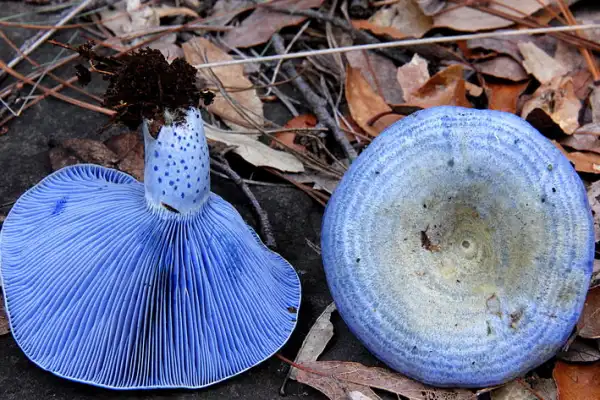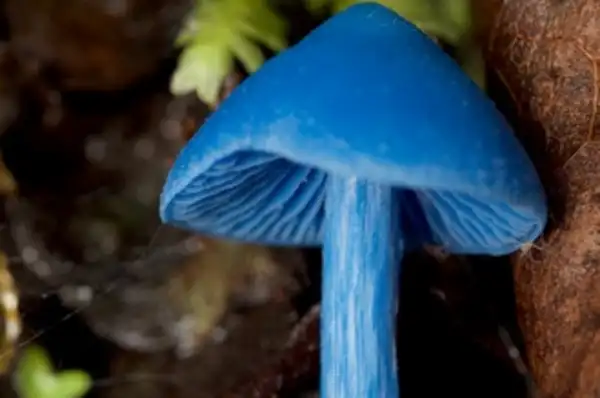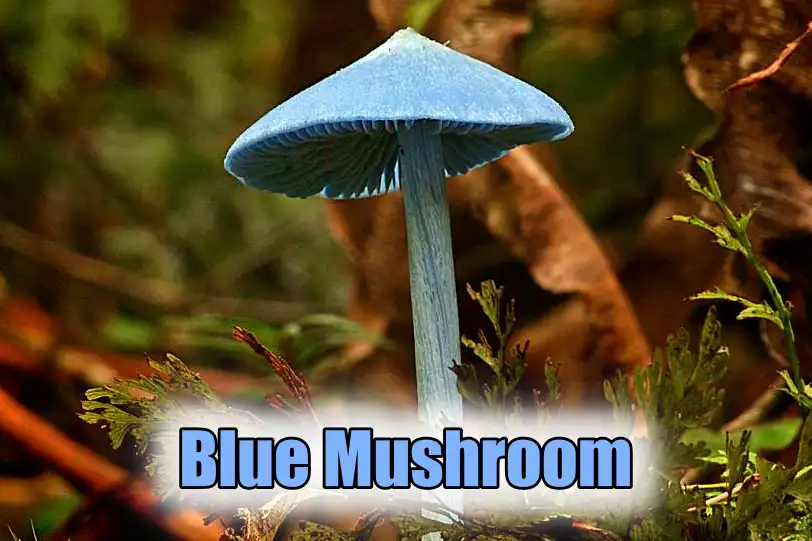Blue is an attractive color, and most of us like the color. But when it comes to nature, blue is rare. It was found that only one in ten plants has blue flowers, and it is even rare in animals. Why is that? Why is blue so rare in nature, especially in terrestrial? It is because there is no specific pigment for blue, and animals or plants need a specific trick to achieve this beautiful color.
Does Blue Mushroom Exist in Nature?
Yes! Blue mushrooms exist in nature. As shocking as it might seem or may not be for some, blue mushrooms are actually seen in nature. Though rare, these mushrooms appear in some parts of the world, as nature never fails to surprise us. We are here to learn a few things about these mesmerizing blue mushrooms.
1. Blue Milk Mushroom

- Botanical Name: Lactarius indigo
- Identification: The cap is 5–15 cm in diameter, and the stem is 2–8 cm.
- Geographical Location: North America, East Asia, and Central America.
This blue mushroom is edible, tastes bitter and peppery, and has a grainy texture. This mushroom has a higher fiber content than button mushrooms. The color of this blue mushroom is due to the presence of an organic compound called azulene.
One interesting fact about this blue mushroom is that when it is bruised or cut with a sharp object, it oozes out a milky blue latex, which turns green after exposure to air. It grows on deciduous and coniferous trees and has a symbiotic relationship (called mycorrhizal association).
2. Blue Pinkgill Mushroom

- Botanical Name: Entoloma hochstetteri
- Identification: The Cap is 4cm in diameter and conical in shape
- Geographical Location: New Zealand
Ever seen New Zealand’s 50-dollar bill? This is the only banknote containing mushrooms. The toxicity of this blue mushroom is unknown. The blue color of this mushroom is due to the azulene organic compound.
This blue mushroom also has a mycorrhizal association. A mythological story exists that the North Island Kokako bird got a blue patch while rubbing its cheek on this blue mushroom. Fascinating right?
3. Mycena subcyanocephala
- Botanical Name: Mycena subcyanocephala
- Identification: Its button is about 1mm tall
- Geographical Location: Taiwan
This blue mushroom is known to be one of the smallest mushrooms in the world. This mushroom was recently found, and hence, there is not much information on it.
It gathers a lot of humidity. Cystidium is found on the surface of this blue mushroom.
4. Violet Webcap Mushroom
- Botanical Name: Cortinarius violaceus
- Identification: The cap is 3–15 cm in diameter and covered with fine, downy scales.
- Geographical Location: North America and Europe
This blue-colored mushroom is both confusingly edible and inedible. After cooking, it tastes bitter. It is disappointing to know that its beautiful blue pigment is difficult to isolate. This blue mushroom grows on deciduous trees like oak, birch, and beech.
This mushroom also has a mycorrhizal association with several species of trees. This blue mushroom grows best in acidic soil.
5. Blue Roundhead Mushroom
- Botanical Name: Stropharia caerulea
- Identification: The conical cap measures a diameter of 2–7.5 cm.
- Geographical Location: Europe and North America
These blue mushrooms are often found on decaying beech trees and alkaline soil. This blue mushroom was misinterpreted to be a psilocybin mushroom. (Magic mushrooms contain psychoactive drugs which cause hallucinations.)
But this mushroom is definitely not edible since it causes gastric upsets.
6. Blewit Mushroom
- Botanical Name: Clitocybe nuda
- Identification: The cap is 3–12 cm in diameter, convex, and curved.
- Geographical Location: North America and Europe
This blue mushroom is widely eaten and is cultivated in Britain, France, and the Netherlands. These blue mushrooms are rich in vitamin C, B1, and vitamin D. They are also rich in potassium, calcium, and folate.
Blewit mushrooms have been present in North America and Europe since ancient times and are used for various culinary dishes.
7. Amethyst Deceiver Mushroom
- Botanical Name: Laccaria amethystina
- Identification: The cap is 1-6 cm in diameter with a central depression
- Geographical Location: Temperate zones of Asia, Europe, and North America
This blue mushroom can absorb arsenic present in the soil. Hence, it makes it inedible, though the mushroom originally was edible. It grows on dead and decaying deciduous and coniferous trees.
These mushrooms grow abundantly after adding ammonia to the soil. Hence, they are also known as ‘ammonia fungi‘. This blue mushroom also forms a mycorrhizal association with beech trees.
8. Velvet blue spread
- Botanical Name: Terana caerulea
- Identification: Thin crust fungus which is less than 1mm in thickness
- Geographical Location: Warmer places like Asia, Africa, New Zealand, and Eastern North America
Have you ever wondered what a blue trunk of a tree would look like? This blue mushroom grows on the damp logs of deciduous trees. The blue pigment of this mushroom consists of a blue pigment, which is a polymer of theophoric acid.
This blue mushroom is finely velvety and waxy when moist.
8. Peppery Roundhead
- Botanical name: Stropharia psuedocyanea
- Identification: bell-shaped, blue-green, and slimy cap
- Geographical location: Britain and Ireland
This beautiful blue gem does not smell like it does. It has a distinct smell of pepper, hence its name. The blue mushroom usually grows up to 4cm wide and 10cm tall. The cap is slimy blue-green and pale at the margin. It gets its name from its color, which means nearly blue. Even their gills have a unique color of milky coffee.
Though the mushroom makes our mouth water, it is also inedible and poisonous.
9. Conifer Blueing Bracket
- Botanical name: Postia caesia
- Identification: blue cap with fine hairs
- Geographical location: Britain and Ireland
The name of the mushroom, Caesia, refers to its sky-blue color. The blue fungus is pale at first but turns blue later as it ages. The blue wood rotting has its favorite, which is pine wood. These can occur singly or in colonies. The blue fungi grow up to 5cm.
What’s surprising is that though these blue spreads do not look edible, they can be eaten.
10. Blue-green Stropharia
- Botanical name: Stropharia aeruginosa
- Identification: slimy convex blue cap with sprinkling white veil remnants
- Geographical location: Britain, Europe, and North America
The blue mushroom is opposite to the above-mentioned one, as it is blue in the beginning but later decolorizes as it matures and becomes yellow. Its name in Latin means covered in verdigris due to the white veil remnants.
The edibility of this blue beauty is still debatable. While some books mention that the mushroom is toxic, the substance or its effect is not known. Some other sources say that the mushroom is edible. So eat this mushroom at your own risk.
11. Blue Chanterelle
- Botanical name: Polyozellus multiplex
- Identification: blue funnel-shaped found in clusters
- Geographical location: the United States and Asia
If you want to look for this blue mushroom by yourself, it would be a difficult job as these are rarely encountered. They have a mutual association with tree roots. An individual grows 3–5 cm wide.
The blue mushroom plays an important role commercially. They are collected and sold in Korea, Japan, and China. The blue mushroom is also found to have medical properties. Polyozelin, a compound present in the mushroom, helps to cure Alzheimer’s disease.
12. Blue-pored Polypore
- Botanical name: Neoalbatrellus caeruleoporus
- Identification: circular, flat, dry, smooth, velvety and with tiny patches
- Geographical location: North America
This is another mushroom, which, in spite of its large size, is challenging to find. The blue mushroom is indeed a gem, as it is really rare in nature. Its expected population is estimated to be below 2,000. These species are so rare that, after looking for over 20 years, the mushroom was never encountered in Oregon or Washington.
The color of the mushroom usually fades away quickly. Well, if the mushroom is so rare, then its edibility is out of the question.
13. Green Earth Tongues
- Botanical name: Microglossum viride
- Identification: blue-green tongue-shaped
- Geographical location: North America, Australia and Europe
The mushroom’s name is derived from its feature, which resembles a tongue. The mushroom is rare in nature. The mushroom grows on rotting wood or grass and camouflages the color. Other species of the same family are found in different colors, like violet.
14. Bleeding Blue Tooth
- Botanical name: Hydnellum cyanopodium
- Identification: irregular cap rough with tiny spots
- Geographical location: California and Oregon
The weird-looking mushroom has its name due to the juicy spots present on the blue background of the cap. The juicy spots, apart from there, have no similarity as they have a disagreeable taste. The mushroom changes from dark blue to violet as it matures.
The blue mushroom is not recommended for eating; it is inedible.
15. Green Elfcup
- Botanical name: Chlorociboria aeruginascens
- Identification: small, cup-shaped blue body
- Geographical location: Britain and Ireland
The name of the mushroom comes from its color, which means becoming blue-green. These tiny creatures can only grow up to 1cm. These beautiful blues infect the wood, and those woods are used as decorations in Italy. You would be mesmerized by seeing these winter beauties.
The blue mushroom rarely occurs in nature, and its edibility is unknown. However, who would want to eat these cute blue mushrooms?
Are blue mushrooms edible?
Since blue is rare in nature, it might seem that what occurs as blue is not edible. But some of the blue mushrooms are edible, and surprisingly, some of them even have medicinal properties. But it is also true that many of the blue mushrooms are poisonous. So identify the fungus properly, and if it is edible, you are all good to go.
Why are blue mushrooms rare in nature?
As we have already discussed above, the blue color is difficult to achieve by the plants or animals in nature. Hence, we find these blue mushrooms limited in number, and even the existing blue mushrooms are rarely seen.
That’s all for today. I hope you enjoyed reading and that it helped you learn a little about the blue mushrooms.
Also Read:
